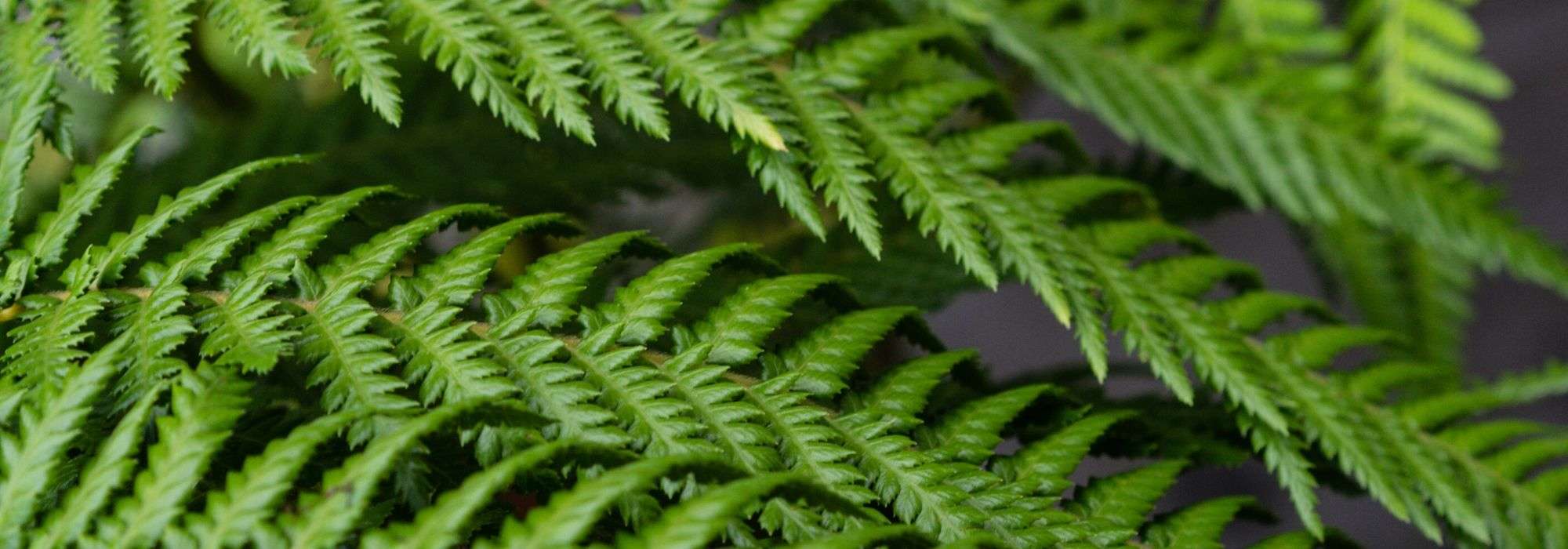
Tree fern: planting, cultivation, maintenance
Contents
Arborescent ferns in a nutshell
- Giant ferns resemble a palm crowned with large fronds
- Their small Jurassic appearance allows for the creation of very exotic displays
- They thrive in humid and shaded environments
- They prefer rich, humus-bearing, and light soils
- Frost-sensitive, they are plants for the Atlantic or Mediterranean coast; elsewhere, they should be grown in pots and brought indoors for winter
The word from our expert
The Tree ferns beautifully represented by Dicksonia antarctica, the hardiest species of the genus, are perfect for creating an exotic and otherworldly atmosphere. With their fibrous brown trunk, they are sometimes referred to as “tree fern” or rather “fern palm,” and it is true that they resemble a rather unique palm!
These giant ferns, native to tropical to subtropical areas or temperate rainforests, thrive in oceanic climates, in sheltered city gardens, or in microclimates. Their cultivation requires a certain expertise: they only flourish in consistently shaded and humid environments, well protected from drying winds.
For short periods, the hardiest, like Dicksonia antarctica and Dicksonia fibrosa, can withstand cold down to -7 to -10°C, or slightly more with protection. Other species have a maximum hardiness of -5 to -7°C. In the less clement regions of our country, they should be grown in pots and brought indoors during winter to a frost-free conservatory that is minimally heated.
Discover our tips for successfully growing these stunning plants with tropical charm!
Description and Botany
“`html
Botanical data
- Latin name Dicksonias sp. and Cyathea sp.
- Family Dicksoniaceae and Cyatheaceae
- Common name Tree fern, Giant fern, Fern palm, Tree fern
- Flowering Does not flower
- Height Generally 1.5 to 3.5 m in cultivation and up to 5-6 m
- Exposure Partial shade to shade
- Soil type Slightly acidic, light, cool and well-drained
- Hardiness Approximately -5 to -10°C depending on species, for short periods
The large tree ferns or Cyatheales have been present on Earth for 145 to 200 million years. They mainly originate from tropical to sub-tropical areas or temperate rainforests, which explains their low hardiness.
There are two main families: Dicksonia (genus named after the English botanist James Dickson) and Cyathea, native to Tasmania, New Zealand, and Australia. Cyathea can be easily distinguished because they have scales at the base of their fronds, which remain dry on their trunk. Their croziers are also scaly, but these fall off when the fronds unfurl. In Dicksonia, hairs replace the scales.
Their fibrous trunk, called a stipe, similar to that of palms, is actually formed by a large vertical extension of the rootstock. It is covered with remnants of old fronds and adventitious roots that plunge from the top to the ground. Other ferns, which could be called “tree-like”, can develop a short or creeping trunk. This is the case with Culcita macrocarpa, the only European member of the Dicksoniaceae, but also with ferns from the genera Blechnum, Woodwardia, Osmunda, Cibotium, Lophosoria, etc.
The vital part of tree ferns is located on a short section of the stipe, just below the leaves. This explains why the terminal part of the trunk must remain moist to ensure its survival!
As with all ferns, leaves appear as tightly coiled and very graphic croziers, resembling the episcopal or pastoral staff of bishops and cardinals. They unfurl into fronds. Once fully extended, they can reach 2 to 3 m in length, with a total span of 2.5 to 5 m depending on the species. Dicksonia produce 1 or 2 frond shoots per year. Cyathea exhibit continuous frond growth from around 10°C, unfurling one after the other. Their finely divided, pinnate or bi-pinnate foliage is only present at the top of the stipe. In rare cases, such as with Dicksonia squarrosa and youngiae, leafy shoots may appear at their base.
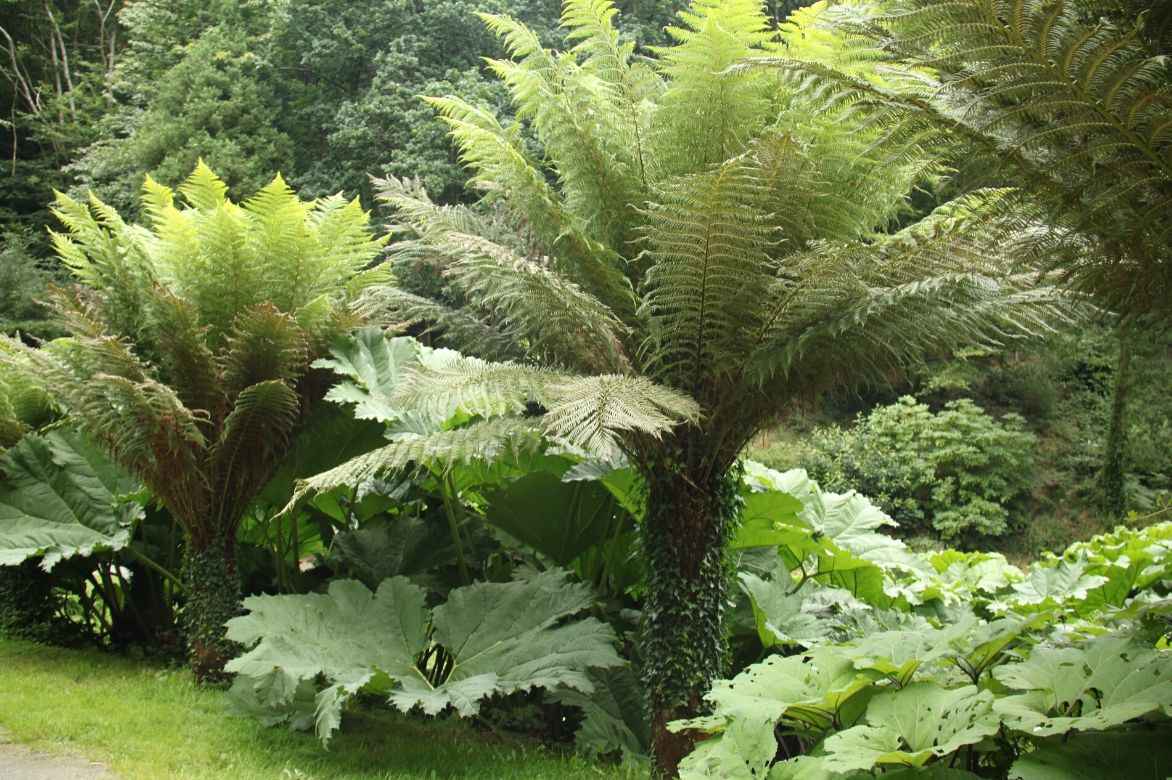
Dicksonia antarctica at the Botanical Conservatory of Brest
The plant propagates by sowing, using its spores located under the leaves. Derived from sporangia, they are grouped in clusters called sori. The sori, well aligned at the bifurcation of the veins, are cup-shaped in Cyathea, hence their name, which in Greek “kuathoo” means “cup”. In Dicksonia, the sori are located near the edges of the leaves.
“`
Read also
Ferns: how to choose them?Main cultivated species
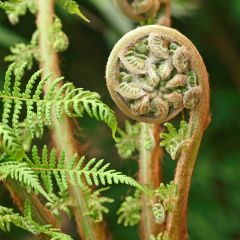
Dicksonia antarctica - Tree Fern
- Height at maturity 6 m
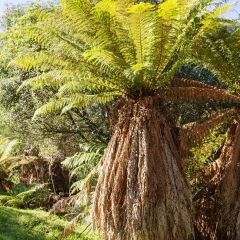
Dicksonia fibrosa - New Zealand Tree Fern
- Height at maturity 3 m
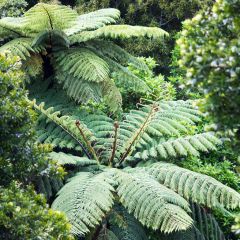
Dicksonia squarrosa - Tree Fern
- Height at maturity 3 m
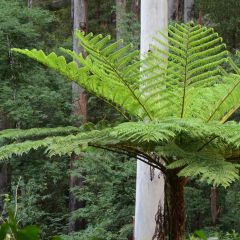
Cyathea cooperi - Australian Tree Fern
- Height at maturity 5,50 m
Discover other Tree Ferns
View all →Available in 1 sizes
Available in 1 sizes
Available in 4 sizes
Available in 1 sizes
Available in 1 sizes
Available in 1 sizes
Available in 1 sizes
Available in 1 sizes
Available in 1 sizes
Available in 1 sizes
Planting
Where to Plant a Giant Fern?
In the Ground, Outdoors
The planting location primarily depends on your climate and the chosen species. A sheltered oceanic climate or an excellent microclimate is necessary to plant a tree fern in the ground. Dicksonia are the most suitable for French gardens, while Cyathea are reserved for very protected areas, such as those close to the coast.
In the ground, a tree fern will offer rapid and vigorous growth. The ideal situation will be partially shaded or even shaded in regions with hot summers. The atmosphere should be naturally cool or regularly kept moist through watering; otherwise, their foliage may scorch.
Generally, tree ferns thrive in the shade of large trees or buildings, at the edge of woodlands, or in courtyards and patios. Exceptionally, they can be planted in sunnier and more open situations in mild and very temperate climates, such as towards the Breton tip, in Cotentin, Cornwall, and the Scilly Islands.
Indoors
Outside of very protected areas, it is preferable to grow them in pots that can be brought indoors to avoid frost in winter. It is challenging to cultivate them in the warm and dry atmospheres of homes. What they truly prefer are temperate to warm greenhouses, conservatories, or winter gardens.
In a greenhouse, it is ideal to plant them in the ground, as watering and ambient humidity are much easier to manage under these conditions. In a conservatory or winter garden, grow them in pots that can be moved to a shaded area in the garden during the warm season, then brought indoors to avoid frost in winter.
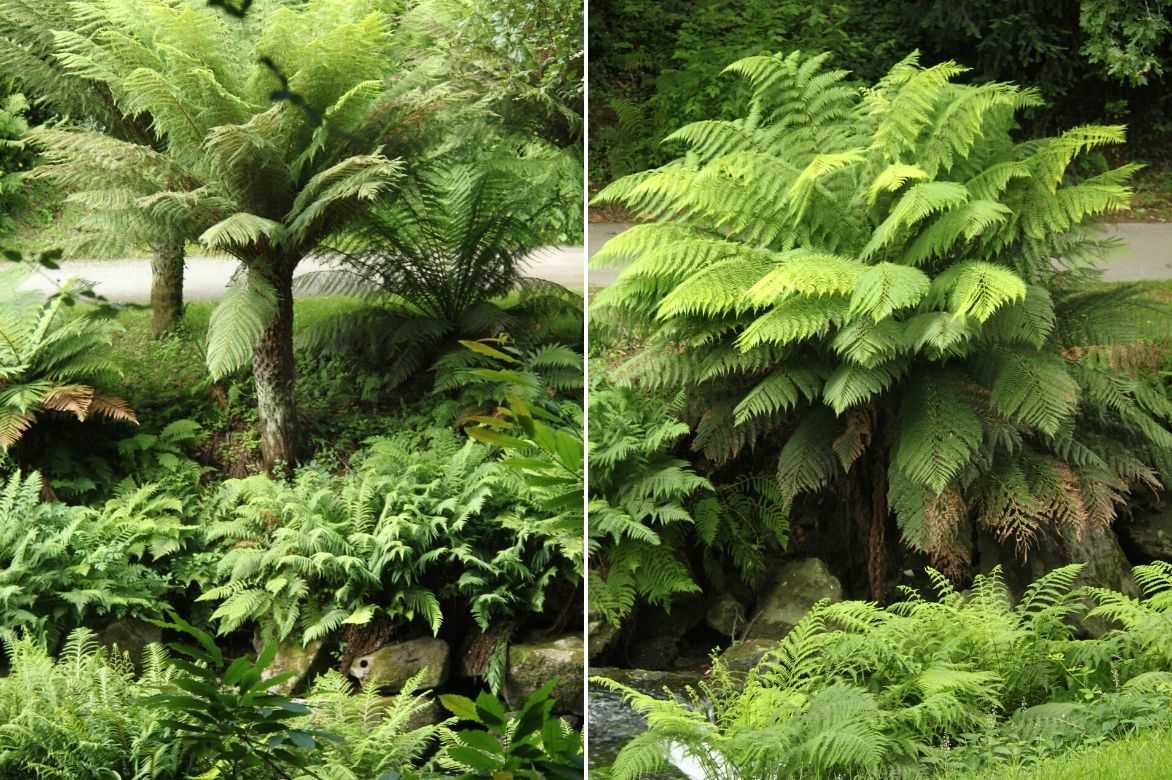 Stunning tree ferns at the Botanical Conservatory of Brest
Stunning tree ferns at the Botanical Conservatory of Brest
How to Plant a Tree Fern?
In the Ground
The soil should be light, porous, slightly acidic, enriched, and well-draining. Add compost to the surface each autumn.
Follow all our advice in our sheet Planting Tree Ferns.
Growing a Tree Fern in a Pot
Repot in January-February in a warm to temperate greenhouse or in March in a cold greenhouse or conservatory. The ideal mix for repotting is ½ heather soil, ¼ rich leaf compost, and ¼ not too coarse pine bark. A pot 40 to 50 cm deep is suitable. Repot every year for the first 10 years, then every 3 to 5 years. With each repotting, the pot should be only slightly larger, about 20 cm wider.
Shade the greenhouse and ventilate while avoiding dry drafts to maintain some moisture. In a conservatory, move the plants to a shaded area during hot weather to prevent exposure to a dry atmosphere.
Read also
How to sow fern spores?Maintenance and Care
Watering a Tree Fern
It is essential to water at the base of the plant, which should remain consistently moist. Also water at the foot of the plant to moisten the soil and increase humidity in the air. It is better to water frequently than to give a large amount infrequently. Installing a drip system at the top of the trunk or a misting system above the tree fern provides ideal conditions. A timer can help ensure you don’t forget to water your fern!
Avoid very hard water for watering. Preferably use rainwater or fairly soft water. Also, avoid spraying the fronds of your tree ferns, as this may cause some leaves to turn black.
Water should drain well after watering and never stagnate at the roots, which could lead to asphyxiation. Water more frequently and for a bit longer in summer, and much less in winter, while still keeping the soil reasonably cool.
In summer, when watering, you can add liquid fertiliser for green plants every 10-15 days. This is more beneficial for potted plants than those in the ground, as it promotes the growth of your tree fern and ensures vibrant green fronds. Reduce the recommended doses by half and stop feeding if your fern is thriving.
How to Protect a Tree Fern in Winter?
It is important to protect the fronds from frost below -2 to -3°C.
In a Warm to Temperate Greenhouse
A greenhouse maintained between 5° and 10°C is perfect for overwintering a Dicksonia or a Cyathea without additional protection. A Cyathea may even continue to produce lovely shoots in winter, above 10°C.
In a Cold Greenhouse or Conservatory
The ideal temperature for overwintering your tree fern is between 0 and 8°C. Beyond this, protect the roots of potted plants if frost is possible or forecasted: wrap the pot in bubble wrap or horticultural fleece. Only protect the trunk from frost if temperatures regularly or persistently drop below -3°C. Follow the same advice as for plants in the ground.
The fronds of Dicksonia antartica should preferably be cut back to ground level to induce dormancy.
In the Ground
In autumn, before the first frosts, lift and tie up the fronds of your tree ferns left in the ground to protect them from the cold and winter snow. Cut about half the length of the fronds and tie them around the crown of your fern to protect the top of the trunk and the terminal buds. Wrap the trunk in horticultural fleece without tightening too much. The soil should also be covered with fern fronds or mulch.
The trunk can remain slightly moist. Ensure it does not dry out during warm spells, due to the low winter sun.
Diseases and potential pests
Tree ferns are generally not affected by pests and diseases.
However, they can suffer from root asphyxiation in poorly drained soil.
Microscopic red spider mites sometimes appear in dry conditions. Regular misting keeps them at bay. If this is not sufficient, a garlic decoction or a dilution of rosemary essential oil will be effective.
Mealybugs are rarely observed, always in dry conditions. You will find all the information to eliminate them in this article: Mealybug: identification and treatment
Multiplication
The propagation of tree ferns is a specialist task… requiring patience and a good heated greenhouse! It takes years before a trunk develops, which explains their cost at purchase.
Sowing
Sowing is possible between March and May in a heated greenhouse at 20-25°C. Spores appear on ferns that are over 10 to 15 years old.
- Sow the spores on turf, in a pot with a perforated base
- Water very gently or better, soak the base in water to avoid disturbing the spores
- Cover with a glass plate and regularly drain the condensation by turning it over
- About two months later, transplant the shoots (fertilised prothalli) into trays, then into pots by 2 or 3
- Keep them in a well-sealed, humid, and shaded greenhouse throughout their development
By removing offsets
It is also possible to separate and replant an offset, or shoot that appears at the base of certain tree ferns. This is the case with Dicksonia squarrosa and D. youngiae.
Which plants should you pair with tree ferns?
Tree ferns blend well with graphic and lush plants, creating a successful exotic atmosphere.
If you want to create a small jungle with a natural look, you can pair your Dicksonia antarctica with ferns like Hart’s tongue fern and Cyrtomium fortunei. A Japanese ginger with yellow flowers will add a welcome floral touch to this exotic scene. Alternatively, you could use a Tetrapanax ‘Rex’ with its enormous, beautifully cut leaves.
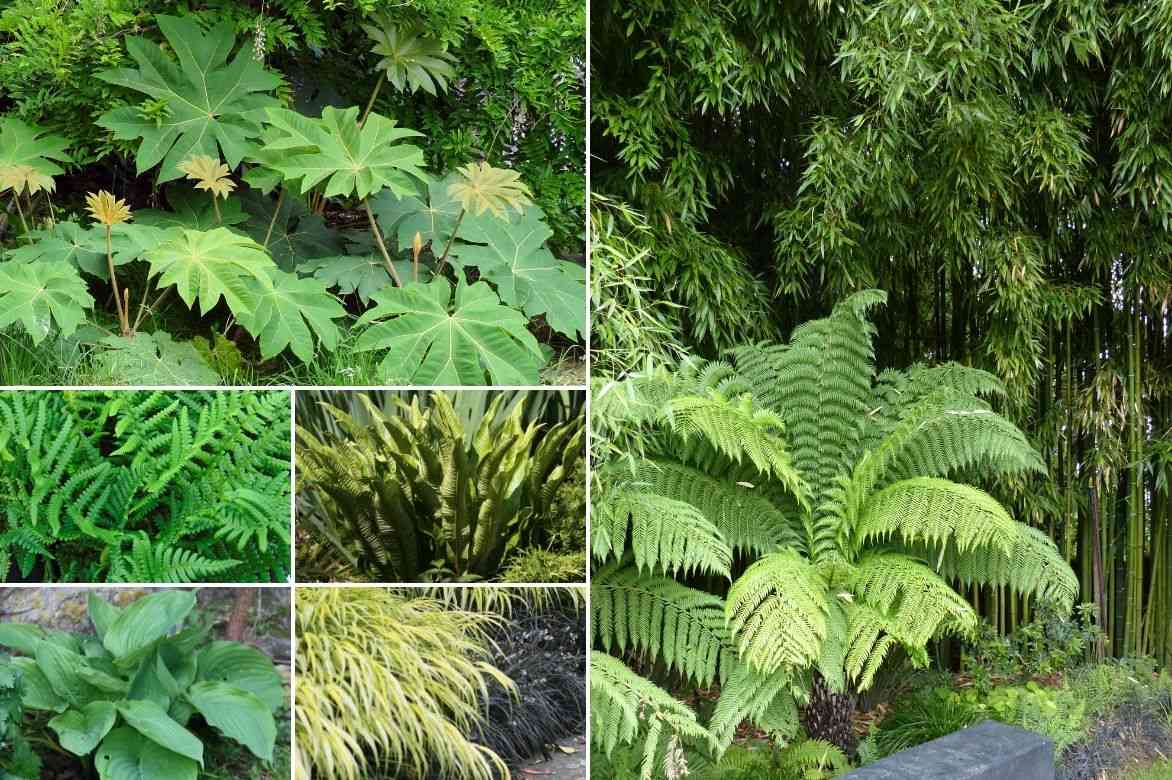
An example of an exotic combination: Tetrapanax papyfera ‘Rex’, Dicksonia antarctica, and beneath their cover, some shade plants like the ferns Dryopteris affinis, Phyllitis scolopendrium, Hosta ‘Sum and Substance’ with large light green leaves, Hakonechloa macra ‘Aureola’, and possibly some large bamboos (such as Phyllostachys) in the background.
You can also use the very tropical foliage of Farfugium near a Dicksonia squarrosa. There are several varieties, either undulate or speckled, depending on your taste. Farfugium japonicum ‘Gigantea’ has large, round, shiny leaves that can reach 45 cm in width! It will be perfect for creating a tropical jungle in your garden. You can brighten the surroundings with Fuchsias ‘Tom Thumb’ and Begonia grandis, which is hardy.
A Cyathea cooperi can, for example, be paired with a Colocasia, with its lush elephant ears, the variegated Japanese fern Athyrium nipponicum ‘Pictum’, and a Begonia with generous, vibrant flowers.
Useful resources
- Discover our wide range of ferns!
- Find your tips for growing a tree fern in a pot
- Visit the Rayol estate and see the Dicksonia and Cyathea in the New Zealand garden
- Discover our plants suitable for creating an exotic atmosphere
- For further reading, check out the book Hardy Ferns for the Garden by Cédric Basset and Olivier Ezavin, published in 2013 by ULMER
Frequently asked questions
-
My tree fern seems dead; its leaves are all dry. What should I do?
It is vital that the top of your tree fern's trunk remains moist at all times. This part may have dried out for too long. Check the base of the stems to see if they are still a bit green; this is very important. If all the fronds are dry down to their base, the fern is certainly dead. However, if some parts of the heart of the fern are still green, there is still hope, and by watering regularly, the young plant should eventually start to recover.
-
Are the leaves of my tree fern stained and damaged in places? Is it a disease?
No, but it is possible that this is due to a watering issue. This is generally what happens when the fronds of this type of fern are sprayed during watering. If this is the case, from now on, water well at the trunk and also at the base of the plant to maintain a cool atmosphere. Misting the foliage is possible, but avoid excessive watering.
- Subscribe!
- Contents
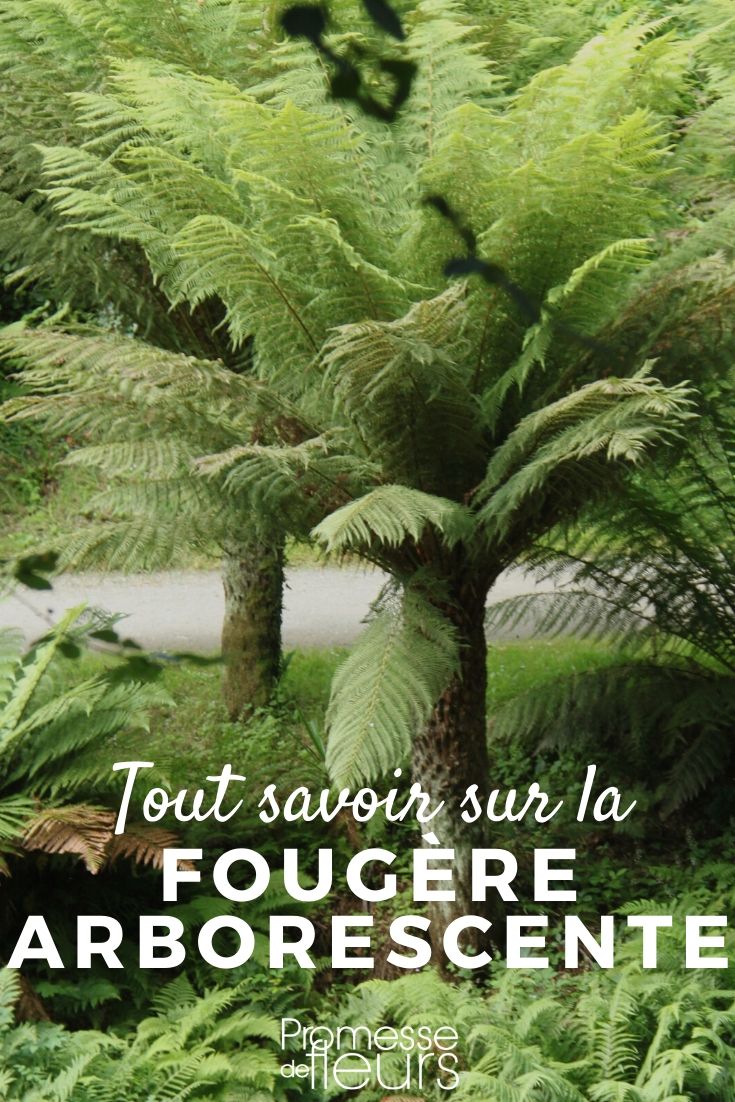
































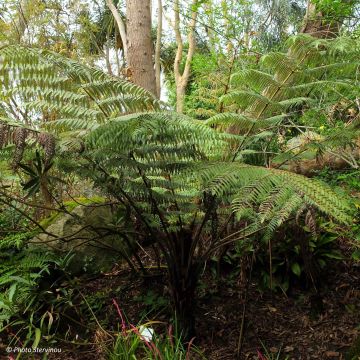

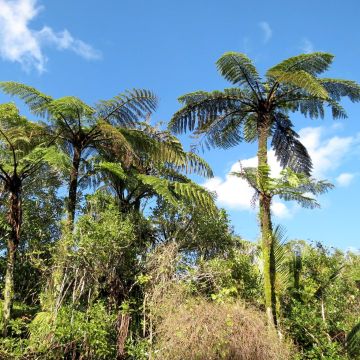
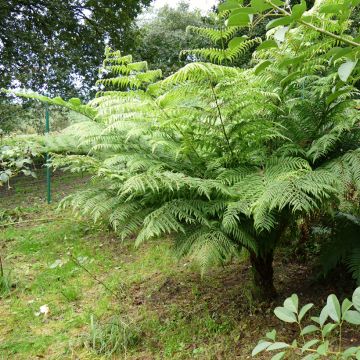


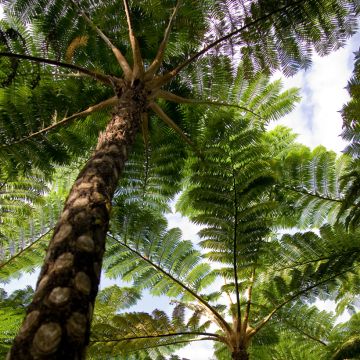
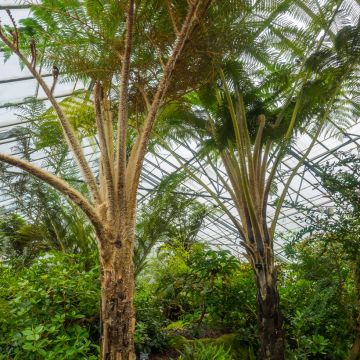
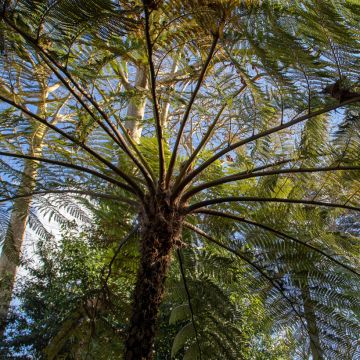
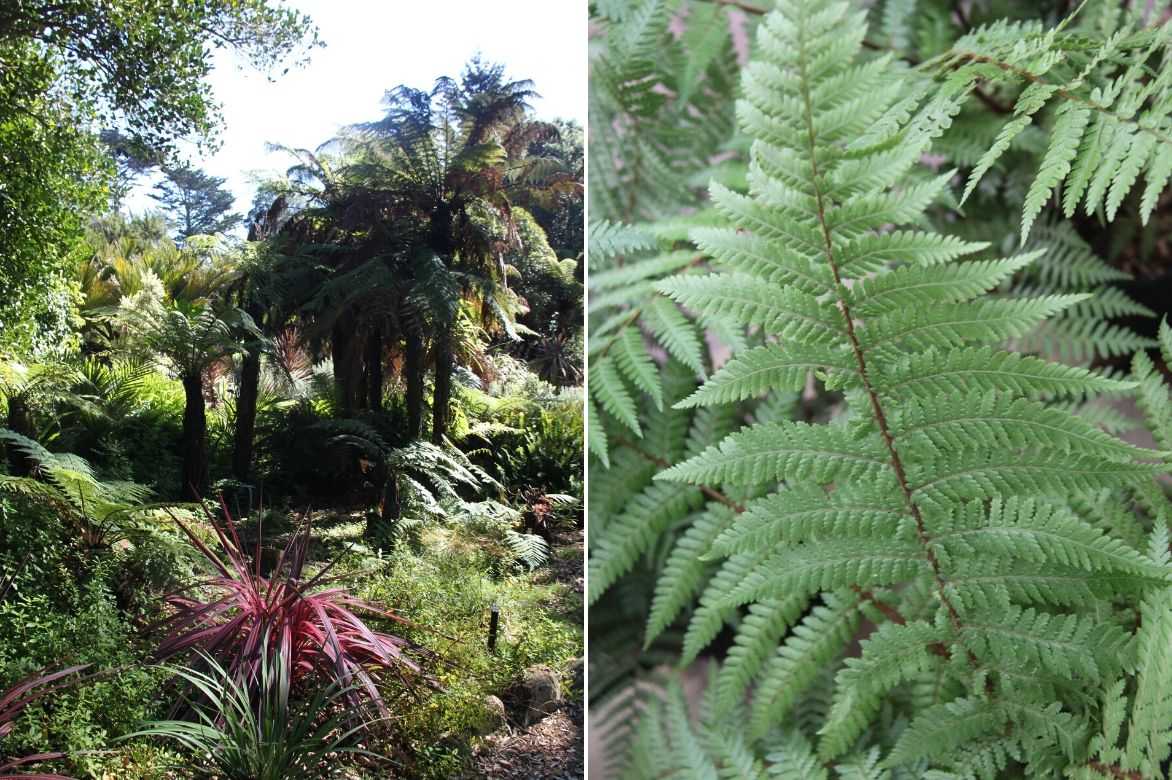
Comments